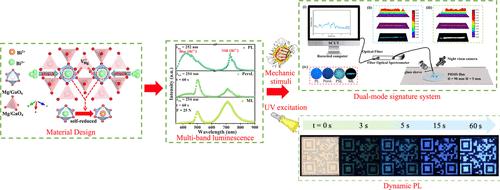当前位置:
X-MOL 学术
›
ACS Appl. Mater. Interfaces
›
论文详情
Our official English website, www.x-mol.net, welcomes your feedback! (Note: you will need to create a separate account there.)
Visible-to-Near-Infrared Mechanoluminescence in Bi-Activated Spinel Compounds for Multiple Information Anticounterfeiting
ACS Applied Materials & Interfaces ( IF 8.3 ) Pub Date : 2024-06-27 , DOI: 10.1021/acsami.4c04499 Zhicong Chen 1 , Peishan Shao 1 , Puxian Xiong 1, 2 , Yao Xiao 1 , Bingjun Liu 1 , Zhiduo Wang 1 , Sheng Wu 3 , Dongliang Jiang 4 , Kang Chen 1 , Jiulin Gan 1 , Dongdan Chen 1 , Zhongmin Yang 1
ACS Applied Materials & Interfaces ( IF 8.3 ) Pub Date : 2024-06-27 , DOI: 10.1021/acsami.4c04499 Zhicong Chen 1 , Peishan Shao 1 , Puxian Xiong 1, 2 , Yao Xiao 1 , Bingjun Liu 1 , Zhiduo Wang 1 , Sheng Wu 3 , Dongliang Jiang 4 , Kang Chen 1 , Jiulin Gan 1 , Dongdan Chen 1 , Zhongmin Yang 1
Affiliation

|
Mechanoluminescence (ML) is the nonthermal luminescence generated in the process of force-to-light conversion, which has broad prospects in stress sensing, wearable devices, biomechanics, and multiple information anticounterfeiting. Multivalence emitter ions utilize their own self-reduction process to realize multiband ML without introducing another dopant, such as Eu3+/Eu2+, Sm3+/Sm2+, and Mn4+/Mn2+. However, self-reduction-induced ML in bismuth-activated materials has rarely been reported so far. In this work, a novel visible-to-near-infrared (vis–NIR) ML induced by the self-reduction of Bi3+ to Bi2+ in the spinel-type compound (MgGa2O4) is reported. The photoluminescence (PL) spectra, PL excitation (PLE) spectra, and PL lifetime curves demonstrate that Bi3+/Bi2+ ions are the main luminescence centers. Notably, the possible self-reduction model is proposed, where a magnesium vacancy (VMg″) is considered as the driving force for the self-reduction of Bi3+ to Bi2+. Furthermore, an oxygen vacancy (VO••) is confirmed by electron paramagnetic resonance (EPR) spectroscopy. Combined with thermoluminescence (TL) glow curves and ML spectra, a plausible trap-controlled ML mechanism is illustrated, where electron–hole (VO••/VMg″) pairs play a significant role in capturing electrons and holes. It is worth noting that the proof-of-concept dual-mode electronic signature application is implemented based on the flexible ML film, which improves the capabilities of signature anticounterfeiting for high-level security applications. Besides, multistimulus-responsive luminescence behaviors of the ML film are realized under the excitation of a 254 nm UV lamp, thermal disturbance, 980 nm laser, and mechanical stimuli. In general, this study provides new insights into designing vis–NIR ML materials toward wider application possibilities.
中文翻译:

用于多重信息防伪的双活化尖晶石化合物中的可见光至近红外机械发光
机械发光(ML)是力-光转换过程中产生的非热发光,在应力传感、可穿戴设备、生物力学、多重信息防伪等方面具有广阔的前景。多价发射离子利用自身的自还原过程实现多波段ML,无需引入其他掺杂剂,例如Eu 3+ /Eu 2+ 、Sm 3+ /Sm < b3> 和 Mn 4+ /Mn 2+ 。然而,迄今为止,铋激活材料中自还原诱导的ML鲜有报道。在这项工作中,尖晶石型化合物中 Bi 3+ 自还原为 Bi 2+ 诱导了一种新型可见光到近红外 (vis-NIR) ML(报道了 MgGa 2 O 4 )。光致发光(PL)光谱、PL激发(PLE)光谱和PL寿命曲线表明Bi 3+ /Bi 2+ 离子是主要的发光中心。值得注意的是,提出了可能的自还原模型,其中镁空位(V Mg ″ )被认为是Bi 3+ 。此外,通过电子顺磁共振(EPR)光谱法确认了氧空位(V O •• )。结合热释光 (TL) 辉光曲线和 ML 光谱,说明了一种合理的陷阱控制 ML 机制,其中电子-空穴 (V O •• /V Mg ″ ) 对在捕获电子和空穴方面发挥着重要作用。值得注意的是,概念验证双模电子签名应用是基于柔性ML薄膜实现的,提高了高级别安全应用的签名防伪能力。 此外,ML薄膜在254 nm紫外灯激发、热扰动、980 nm激光和机械刺激下实现了多刺激响应发光行为。总的来说,这项研究为设计 vis-NIR ML 材料提供了新的见解,以实现更广泛的应用可能性。
更新日期:2024-06-30
中文翻译:

用于多重信息防伪的双活化尖晶石化合物中的可见光至近红外机械发光
机械发光(ML)是力-光转换过程中产生的非热发光,在应力传感、可穿戴设备、生物力学、多重信息防伪等方面具有广阔的前景。多价发射离子利用自身的自还原过程实现多波段ML,无需引入其他掺杂剂,例如Eu 3+ /Eu 2+ 、Sm 3+ /Sm < b3> 和 Mn 4+ /Mn 2+ 。然而,迄今为止,铋激活材料中自还原诱导的ML鲜有报道。在这项工作中,尖晶石型化合物中 Bi 3+ 自还原为 Bi 2+ 诱导了一种新型可见光到近红外 (vis-NIR) ML(报道了 MgGa 2 O 4 )。光致发光(PL)光谱、PL激发(PLE)光谱和PL寿命曲线表明Bi 3+ /Bi 2+ 离子是主要的发光中心。值得注意的是,提出了可能的自还原模型,其中镁空位(V Mg ″ )被认为是Bi 3+ 。此外,通过电子顺磁共振(EPR)光谱法确认了氧空位(V O •• )。结合热释光 (TL) 辉光曲线和 ML 光谱,说明了一种合理的陷阱控制 ML 机制,其中电子-空穴 (V O •• /V Mg ″ ) 对在捕获电子和空穴方面发挥着重要作用。值得注意的是,概念验证双模电子签名应用是基于柔性ML薄膜实现的,提高了高级别安全应用的签名防伪能力。 此外,ML薄膜在254 nm紫外灯激发、热扰动、980 nm激光和机械刺激下实现了多刺激响应发光行为。总的来说,这项研究为设计 vis-NIR ML 材料提供了新的见解,以实现更广泛的应用可能性。






































 京公网安备 11010802027423号
京公网安备 11010802027423号